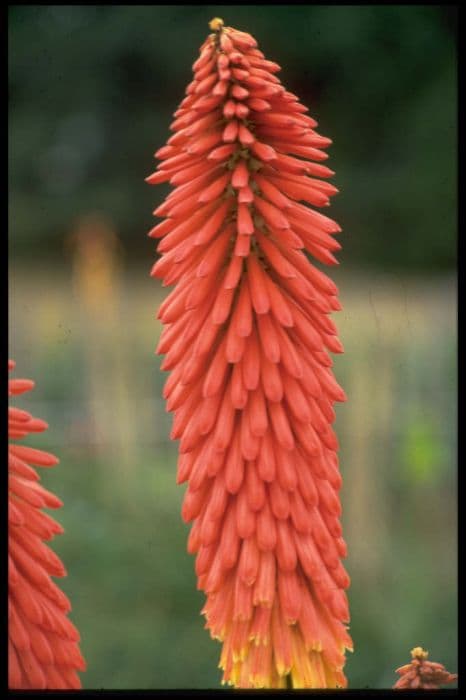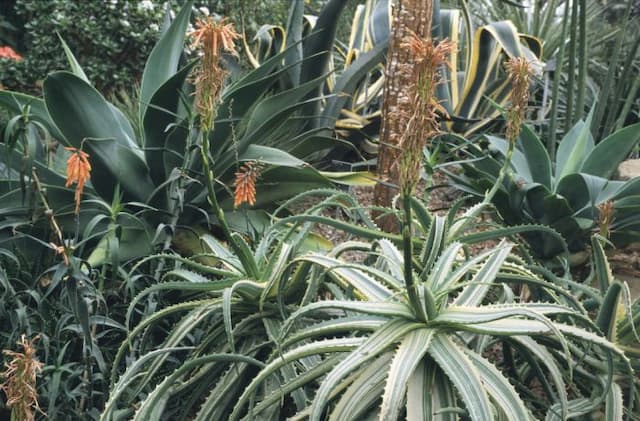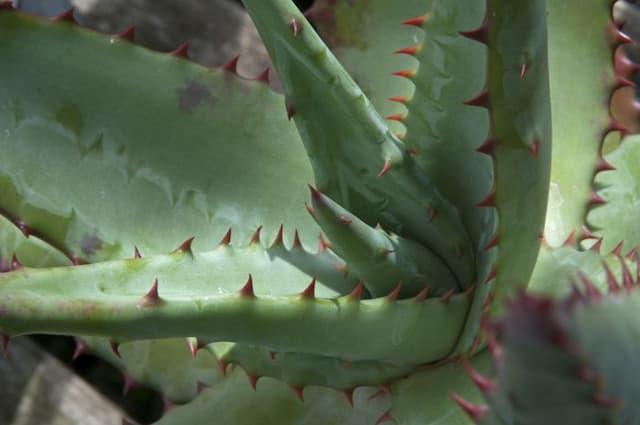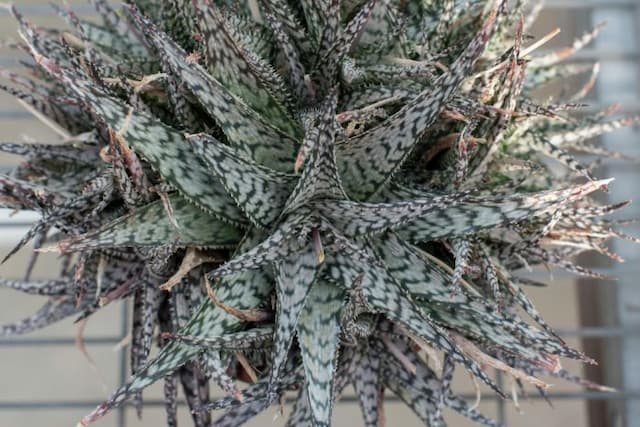Red-hot poker 'Samuel's Sensation' Kniphofia 'Samuel's Sensation' Samuel

ABOUT
'Samuel's Sensation' is a robust herbaceous perennial to 1.5m in height, forming a large clump of long, narrow leaves. In late summer and early autumn strong purplish stems bear spikes of scarlet flowers which become tinged with yellow as they age
About this plant
 Names
NamesFamily
Asphodelaceae
Synonyms
Red Hot Poker, Torch Lily, Poker Plant
Common names
Kniphofia 'Samuel's Sensation'.
 Characteristics
CharacteristicsLife cycle
Perennials
Foliage type
Evergreen
Color of leaves
Green
Flower color
Orange
Height
3-4 feet (0.91-1.22 meters)
Spread
2 feet (0.61 meters)
Plant type
Herbaceous
Hardiness zones
6
Native area
South Africa
Benefits
 General Benefits
General Benefits- Attracts pollinators: Provides nectar for bees, butterflies, and hummingbirds, encouraging biodiversity in the garden.
- Drought tolerant: Once established, it has low water requirements, making it suitable for xeriscaping or dry climates.
- Low maintenance: Requires minimal care beyond basic watering and occasional feeding, suitable for gardeners of all levels.
- Long blooming period: Flowers from late spring to early autumn, offering a long season of visual interest.
- Architectural interest: Its tall flower spikes and grass-like foliage add height and texture to garden beds or borders.
- Deer resistant: Less likely to be eaten by deer, preventing damage to the plant and preserving garden aesthetics.
- Varied landscaping uses: Works well in a variety of garden styles, including cottage gardens, coastal gardens, and contemporary landscapes.
- Color variety: The vibrant orange to red blossoms provide a bold color statement in any garden setting.
 Medical Properties
Medical PropertiesThis plant is not used for medical purposes.
 Air-purifying Qualities
Air-purifying QualitiesThis plant is not specifically known for air purifying qualities.
 Other Uses
Other Uses- Photography subject: Red hot poker's unique and striking appearance makes it a delightful subject for both professional and amateur photographers.
- Garden sculpture: When not in bloom, the architectural form of red hot poker can serve as a natural sculpture within the landscape.
- Horticultural education: Red hot poker can be used in botanical gardens and educational workshops to demonstrate plant adaptation to attract pollinators.
- Theme gardens: With its bold appearance, it's ideal for fire or volcano-themed gardens, providing a visual representation of flames.
- Erosion control: Planted in groups, red hot poker's root systems can help stabilize soil and control erosion on slopes.
- Nectar bar: The plant can be used to create a nectar bar garden to support a variety of pollinators, including hummingbirds and butterflies.
- Eco-friendly dye: The flowers of red hot poker could potentially be used to produce eco-friendly dyes for textiles or crafts.
- Climate change study: As a plant sensitive to climatic conditions, red hot poker could help in studying the impacts of climate change on blooming times and plant health.
- Drama productions: Can be used in stage design for dramatic effect, particularly in plays or scenes that require an exotic or tropical ambiance.
- Culinary decoration: While not edible, the flowers could be used as a temporary ornamental decoration in dishes for upscale restaurants, as long as they are removed before consumption.
Interesting Facts
 Feng Shui
Feng ShuiThe Red Hot Poker is not used in Feng Shui practice.
 Zodiac Sign Compitability
Zodiac Sign CompitabilityThe Red Hot Poker is not used in astrology practice.
 Plant Symbolism
Plant Symbolism- Standout Individuality: The Kniphofia, commonly known as Red Hot Poker, with its bright and striking flower spikes, represents standing out from the crowd and showcasing one's unique qualities.
- Vibrancy and Energy: Due to its fiery and vivid blossoms, the Red Hot Poker symbolizes a vibrant spirit and high energy, akin to the lively flames of a fire.
- Attraction: The intense colors of the plant can represent magnetism and allure, suggesting that it may draw attention and captivate onlookers.
- Wealth and Prosperity: In some cultures, the Red Hot Poker is associated with good fortune and abundance, making it a symbol of wealth and prosperity.
- Courage and Boldness: The robust nature of the plant, which can thrive in harsh conditions, is emblematic of bravery and the courage to face challenges head-on.
 Water
WaterRed Hot Poker (the common name for Kniphofia 'Samuel's Sensation' Samuel) should be watered deeply once a week, ensuring that the soil is soaked 1 to 2 inches deep. During hotter, dry spells, you may need to water twice a week. It’s important to allow the soil to dry out slightly between waterings to avoid root rot. A good rule of thumb is to provide about 1 gallon of water per plant for each watering session. Once established, Red Hot Pokers are quite drought-tolerant, so you can reduce the frequency of watering. Adjust watering habits seasonally as the plant's needs will decrease during cooler, wetter periods.
 Light
LightRed Hot Pokers thrive in full sun conditions, requiring at least 6 to 8 hours of direct sunlight daily. The ideal spot for Kniphofia 'Samuel's Sensation' Samuel is in an area where it can receive unfiltered sunshine throughout the day. These plants can tolerate some light shade, especially in the afternoon, but too little light can reduce flowering.
 Temperature
TemperatureThe Red Hot Poker plant prefers temperate conditions and can tolerate a temperature range from approximately 50 to 90 degrees Fahrenheit. It is hardy in USDA zones 6 to 9, withstanding brief periods of colder temperatures down to about 0 degrees Fahrenheit. The optimal temperature for growth and flowering is between 60 and 75 degrees Fahrenheit.
 Pruning
PruningPruning Red Hot Pokers should be done to remove spent flower spikes and tidy up the plant, which encourages a second bloom and prevents self-seeding. It’s best to prune just after the first flowering has finished, typically in late spring or early summer. Remove only the dead flower stalks and any damaged or dead foliage, and in the winter, cut the foliage back to about 3 inches above ground to prepare for new spring growth.
 Cleaning
CleaningAs needed
 Soil
SoilRed Hot Poker 'Samuel's Sensation' (the common name of Kniphofia 'Samuel's Sensation') thrives best in well-draining soil with a mix of loam and sharp sand to promote good water drainage. Incorporating organic matter like compost will provide necessary nutrients. The ideal soil pH for this plant is between 6.0 to 6.5, slightly acidic to neutral.
 Repotting
RepottingRed Hot Poker 'Samuel's Sensation' typically doesn't need frequent repotting as it is a perennial plant that grows well when left undisturbed. Repotting can be done every 3-4 years or when the plant has outgrown its current container or the soil has become depleted.
 Humidity & Misting
Humidity & MistingRed Hot Poker 'Samuel's Sensation' is adaptable to a wide range of humidity levels and typically does well in the natural atmospheric humidity found outdoors. It doesn't have specific humidity needs and can tolerate the dry air conditions found in most temperate climates.
 Suitable locations
Suitable locationsIndoor
Ensure bright light, well-draining soil; avoid overwatering.
Outdoor
Full sun, well-drained soil, protect from intense winter.
Hardiness zone
6-9 USDA
 Life cycle
Life cycleRed Hot Poker 'Samuel's Sensation' starts its life cycle when its seeds germinate in late spring after the last frosts, in moist soil and with plenty of sunlight. Seedlings emerge and develop into rosettes of long, strap-like leaves, establishing a firm root system. As the plant matures, usually by the second year, a tall, sturdy flower stalk shoots up from the center of the foliage clump in late spring to early summer, displaying impressive spikes of tubular, red-orange flowers that are highly attractive to hummingbirds and other pollinators. After blooming, the plant sets seed, which can be collected or allowed to fall naturally to potentially germinate and create new plants. Throughout the growing season, the foliage remains evergreen, providing year-round interest. In winter or at the end of its life cycle, the plant may die back, especially in colder climates, but it is perennial and will typically regrow from its base in the following spring if the crown has been protected from severe frosts.
 Propogation
PropogationPropogation time
Spring to Summer
Kniphofia 'Samuel's Sensation', commonly known as Red Hot Poker, is typically propagated by division. The best time to divide Red Hot Pokers is in the spring or early autumn when the plant is not in active growth. To propagate by division, carefully dig up the clump of the plant and use a sharp spade or knife to cut the clump into smaller sections, ensuring each division has a portion of the root system and several growing points. Replant the divisions at the same soil depth they were previously growing and water well after planting. This method allows gardeners to quickly increase their stock of the plant while maintaining the health and characteristics of the parent plant.









